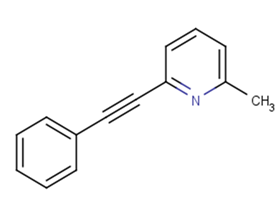
MPEP
CAS No. 96206-92-7
MPEP( —— )
Catalog No. M19286 CAS No. 96206-92-7
MPEP is a selective mGlu5 receptor antagonist with IC50 of 36 nM, exhibits no appreciable activity at mGlu1b/2/3/4a/7b/8a/6 receptors.
Purity : >98% (HPLC)
 COA
COA
 Datasheet
Datasheet
 HNMR
HNMR
 HPLC
HPLC
 MSDS
MSDS
 Handing Instructions
Handing Instructions
| Size | Price / USD | Stock | Quantity |
| 10MG | 42 | Get Quote |


|
| 25MG | 88 | Get Quote |


|
| 50MG | 162 | Get Quote |


|
| 100MG | 260 | Get Quote |


|
| 200MG | 428 | Get Quote |


|
| 500MG | Get Quote | Get Quote |


|
| 1G | Get Quote | Get Quote |


|
Biological Information
-
Product NameMPEP
-
NoteResearch use only, not for human use.
-
Brief DescriptionMPEP is a selective mGlu5 receptor antagonist with IC50 of 36 nM, exhibits no appreciable activity at mGlu1b/2/3/4a/7b/8a/6 receptors.
-
DescriptionMPEP is a selective mGlu5 receptor antagonist with IC50 of 36 nM, exhibits no appreciable activity at mGlu1b/2/3/4a/7b/8a/6 receptors.(In Vitro):MPEP does not show agonist or antagonist activity at 100 mM on human mGlu2, -3, -4a, -7b, and -8a receptors nor at 10 μM on the human mGlu6 receptor.(In Vivo):MPEP (1-30 mg/kg) induces anxiolytic-like effects in the conflict drinking test and the elevated plus-maze test in rats as well as in the four-plate test in mice.MPEP (1-20 mg/kg) does shorten the immobility time in a tail suspension test in mice, however it is inactive in the behavioural despair test in rats.MPEP (30 mg/kg i.p.) slightly but significantly increases (by 39%) the number of punished crossings in the four-plate test, lower doses of the compound (3 and 10 mg/kg) does not affect the number of punished crossings in that test (F (3,36)=3.240, P<0.05).MPEP (1, 10 and 20 mg/kg) significantly (by 55% after the highest dose), (F(3,28)=15.47, P<0.001) decreases the immobility time of mice in the tail suspension test. Its efficacy is similar to that of imipramine (20 mg/kg), used as the positive standard.
-
In VitroMPEP does not show agonist or antagonist activity at 100 mM on human mGlu2, -3, -4a, -7b, and -8a receptors nor at 10 μM on the human mGlu6 receptor.
-
In VivoMPEP (1-30 mg/kg) induces anxiolytic-like effects in the conflict drinking test and the elevated plus-maze test in rats as well as in the four-plate test in mice.MPEP (1-20 mg/kg) does shorten the immobility time in a tail suspension test in mice, however it is inactive in the behavioural despair test in rats.MPEP (30 mg/kg i.p.) slightly but significantly increases (by 39%) the number of punished crossings in the four-plate test, lower doses of the compound (3 and 10 mg/kg) does not affect the number of punished crossings in that test (F (3,36)=3.240, P<0.05). MPEP (1, 10 and 20 mg/kg) significantly (by 55% after the highest dose), (F(3,28)=15.47, P<0.001) decreases the immobility time of mice in the tail suspension test. Its efficacy is similar to that of imipramine (20 mg/kg), used as the positive standard. Animal Model:Male Wistar rats (200 ± 250 g).Dosage:IP or PO.Administration:0.3, 1 and 10 mg/kg, i.p. (Conflict drinking test).Result:At a dose of 0.3 mg/kg was not ffective, at doses of 1 and 10 mg/kg i.p. significantly (F (3,30)=11.193, P<0.001), increased the number of shocks (by 330 and 507%, respectively) accepted during the experimental session in the Vogel test. Animal Model:Male Wistar rats (200 ± 250 g).Dosage:IP or PO.Administration:1, 3 and 10 mg/kg, i.p. or 10 and 30 mg/kg, p.o.(Elevated plus-maze test).Result:Administered at a dose of 1 mg kg71 i.p. did not change the entries into and time spent in the open arms. At doses of 3 and 10 mg/kg i.p. significantly (F (3,24)=22.978, P<0.001) dose-dependently increased the time spent in the open arms (up to 45 and 74%, respectively), and the percentage of entries into the open arms (up to 48 and 68%, respectively, F(3,24)=5.678, P<.01). At doses of 3 and 10 mg/kg i.p. significantly increased (by 64%) the total number of entries and reduced (by about 25%) the total time spent (data not shown) in the arms (either type). At the dose of 30 mg/kg (po, but not 10 mg/kg) significantly (up to 64%, F (2,16)=14.249, P<0.001) increased the percentage of the time spent in the open arms and the percentage of entries into the open arms (up to 63%, F (2,16)=7.295, P<0.01). MPEP given p.o. in both doses used did not change the total number of entries nor the total time spent in the arms (either type).
-
Synonyms——
-
PathwayOthers
-
TargetOther Targets
-
RecptormGluR5
-
Research AreaNeurological Disease
-
Indication——
Chemical Information
-
CAS Number96206-92-7
-
Formula Weight193.24
-
Molecular FormulaC14H11N
-
Purity>98% (HPLC)
-
SolubilityIn Vitro:?DMSO : 100 mg/mL (517.49 mM)
-
SMILESCC1=NC(=CC=C1)C#CC1=CC=CC=C1
-
Chemical Name——
Shipping & Storage Information
-
Storage(-20℃)
-
ShippingWith Ice Pack
-
Stability≥ 2 years
Reference
1. Gasparini F, et al. Neuropharmacology, 1999, 38(10), 1493-1503.
molnova catalog



related products
-
N-Acetyl-Ser-Asp-Lys...
N-Acetyl-Ser-Asp-Lys-Pro (TFA), an endogenous tetrapeptide secreted by bone marrow, is a specific substrate for the N-terminal site of ACE.
-
Protein Kinase G Sub...
Protein Kinase G Substrate; G-Subtide
-
Boc-Val-Cit-OH
Boc-Val-Cit-OH is a cleavable ADC linker used in the synthesis of antibody-drug conjugates (ADCs).



 Cart
Cart
 sales@molnova.com
sales@molnova.com


